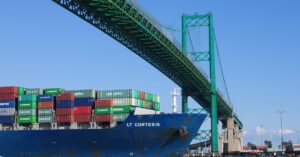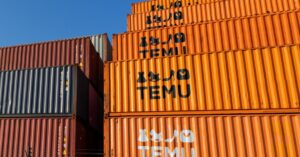Artificial Intelligence has been all the rage recently, and it is not surprising that supply chains are rapidly integrating the technology into their operations.
In this newsletter, we will be exploring the dramatic rise of GenAI in supply chains across the globe and what supply chains must prioritize to make the most of it. Later in the article, we explore the freight market recovery and why it is still elusive, contrary to expectations. Diesel pricing is behaving strangely, leading many to believe it might be a demand problem. Many disagree, though.
Continue reading to find out more.
Generative AI is Revolutionizing Supply Chain Management
Generative AI has enjoyed a rapid rise in supply chain management, and Google’s cloud Vertex AI and GenAI are a big reason for this.
While Generative AI is not a recent find for supply chain operators, not many expected the rapid rise and adoption of the technology within the ecosystem. The capabilities of the tech solution are growing exponentially, with real-world applications already in place. The new GenAI models are revolutionary as they can generate context behind logistics operations, enabling them to fill in missing data points. 2023 saw Google and other organizations offering AI solutions and supply chain tech to validate their proof-of-concepts. In 2024, businesses are now actively investing in GenAI.
To get started with GenAI in supply chains, prioritizing values, building an expert team, experimenting, data collection, system integration, and gradual expansion are critical. The only thing that could be more crucial than that is finding a reliable tech-forward logistics partner.
Freight Market Recovery Still Elusive
Unfortunately, there are no signs of a market turnaround that many stakeholders are anticipating in the freight cycle, according to the Cass Freight Index.
Shipments were down 1.6%, and April volumes were the lowest since January. On the other hand, expenditures were down 16.8% y/y and 1.9% from a seasonally adjusted March. Contract rates may show some signs of stabilization, though, as the Truckload Linehaul Index went down 3.8% y/y but remained flat compared to March.
Overall, the freight economic situation is favorable for long-term growth, and the Cass data also suggests a significant decline in freight rates compared to the previous two years.
Diesel Demand in Flux?
Despite the geographical tensions, the benchmark diesel price used for fuel surcharges has been on a free fall for five consecutive weeks. It recently reached its lowest level since late January.
Surprisingly, the geographical tensions in the Middle East have had minimal impact on current diesel prices. Many experts believe that the rising production of renewable diesel, made from plant oils and animal fats, plays a key role in weakening the diesel market. However, this trend is not captured in traditional consumption data. Refiners are also increasingly focusing on renewable diesel production, which has impacted their bottom line.
The freight winter hasn’t helped matters either as weak demand could be reflected in the low diesel prices. While some experts reject this conjecture, they still expect flat demand in the coming months.
Strong Consumer Spending Expected to Keep U.S. Ports Busy
The National Retail Federation and Hackett Associates have predicted high import volumes throughout 2024.
The loaded import volumes at the top 12 container ports are expected to remain above 2 million TEUs through October 2024, marking the highest sustained volume in years. And it is driven by strong consumer spending. May 2024 is projected to be the first month exceeding 2 million TEUs since October 2023, a strong sign of cargo recovery. Even the pre-pandemic volumes rarely surpassed 2 million TEUs monthly.
Despite strong recovery signs and growth, geopolitical tensions are still a strong factor in international trade, and it is unclear whether the surge will continue or level off.
Maersk is Expanding Its Air Cargo Network with a New Miami Facility
In April, A.P. Moller-Maersk launched a full-service air cargo hub in Miami.
The 90,000-square-foot facility will focus on transhipping cargo from Europe and Asia to Latin America. Doing this effectively will mean leveraging Miami International Airport’s strong connectivity to the region. The airport handles 85% of Latin American air imports and 80% of exports. According to Maersk, the new facility will ensure predictable transit times in Maersk’s global network, as well as improved connectivity, flexibility, and reliability in cargo movement operations.
Maersk Miami hub is the latest facility since Maersk launched its air cargo operations in 2022, and it joins a list of established operations in Atlanta, Chicago, and Los Angeles in recent years.
Signs of Improvement in The Truck Market, Despite Dismal Q1
The trucking industry had a rough start to 2024.
The truck freight recession continued in Q1 as volumes remained lackluster. Truckload spot rates and contract rates declined year-over-year as excess capacity continued to put downward pressure on rates. Despite the poor performance, there are some signs of optimism. Truckstop’s Market Demand Index suggests rising demand and potential rate increases. And Bank of America’s Truckload Demand Indicator reached its highest level since June 2022. Then there is the show of early strength in the produce market that is boosting refrigerated truckload demand.
Experts believe that all of this is a sign that the truckload market may improve in the second half of the year. However, they have been wrong before, so we wait and see.
Leveraging COGISTICS Means Seamless Logistics Operations
COGISTICS Transportation is your partner when you want seamless logistics operations. We simplify global freight by leveraging 30+ years of expertise, technology, and innovative solutions. From the land to the air and sea, our operations are running 24/7, worldwide because your success is our priority. Connect with us today.




